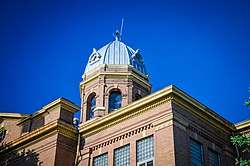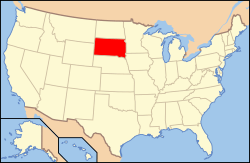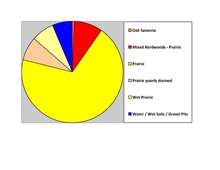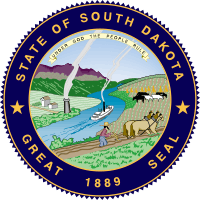Roberts County, South Dakota
| Roberts County, South Dakota | |
|---|---|
 | |
 Location in the U.S. state of South Dakota | |
 South Dakota's location in the U.S. | |
| Founded | March 8, 1883[1] |
| Named for | S. G. Roberts |
| Seat | Sisseton |
| Largest city | Sisseton |
| Area | |
| • Total | 1,136 sq mi (2,942 km2) |
| • Land | 1,101 sq mi (2,852 km2) |
| • Water | 35 sq mi (91 km2), 3.1% |
| Population (est.) | |
| • (2016) | 10,255 |
| • Density | 9.2/sq mi (3.6/km2) |
| Congressional district | At-large |
| Time zone | Central: UTC−6/−5 |
| Website |
roberts |
Roberts County is a county located in the U.S. state of South Dakota. As of the 2010 census, the population was 10,149.[2] Its county seat is Sisseton.[3] The county was named either for S. G. Roberts of Fargo, North Dakota, or for Solomon Robar, an early local French fur trader.[1]
Geography

According to the U.S. Census Bureau, the county has a total area of 1,136 square miles (2,940 km2), of which 1,101 square miles (2,850 km2) is land and 35 square miles (91 km2) (3.1%) is water.[4] The Traverse Gap is located in Eastern Roberts County along the Minnesota border. The Lake Traverse Indian Reservation is also located in the county.
Major highways
Adjacent counties
- Richland County, North Dakota - north
- Traverse County, Minnesota - northeast
- Big Stone County, Minnesota - southeast
- Grant County, South Dakota - south
- Day County, South Dakota - southwest
- Marshall County, South Dakota - west
Protected areas
- Big Stone Island Nature Area
- Hartford Beach State Park
- Sica Hollow State Park (part)
Lakes and rivers
Demographics
| Historical population | |||
|---|---|---|---|
| Census | Pop. | %± | |
| 1890 | 1,997 | — | |
| 1900 | 12,216 | 511.7% | |
| 1910 | 14,897 | 21.9% | |
| 1920 | 16,514 | 10.9% | |
| 1930 | 15,782 | −4.4% | |
| 1940 | 15,887 | 0.7% | |
| 1950 | 14,929 | −6.0% | |
| 1960 | 13,190 | −11.6% | |
| 1970 | 11,678 | −11.5% | |
| 1980 | 10,911 | −6.6% | |
| 1990 | 9,914 | −9.1% | |
| 2000 | 10,016 | 1.0% | |
| 2010 | 10,149 | 1.3% | |
| Est. 2017 | 10,278 | [5] | 1.3% |
| U.S. Decennial Census[6] 1790-1960[7] 1900-1990[8] 1990-2000[9] 2010-2016[2] | |||
2000 census
As of the census[10] of 2000, there were 10,016 people, 3,683 households, and 2,618 families residing in the county. The population density was 9 people per square mile (4/km²). There were 4,734 housing units at an average density of 4 per square mile (2/km²). The racial makeup of the county was 68.29% White, 0.10% Black or African American, 29.86% Native American, 0.21% Asian, 0.03% from other races, and 1.51% from two or more races. 0.63% of the population were Hispanic or Latino of any race.
There were 3,683 households out of which 33.80% had children under the age of 18 living with them, 53.50% were married couples living together, 11.80% had a female householder with no husband present, and 28.90% were non-families. 26.80% of all households were made up of individuals and 12.40% had someone living alone who was 65 years of age or older. The average household size was 2.66 and the average family size was 3.22.
In the county, the population was spread out with 30.00% under the age of 18, 7.20% from 18 to 24, 23.60% from 25 to 44, 22.20% from 45 to 64, and 17.00% who were 65 years of age or older. The median age was 37 years. For every 100 females there were 98.80 males. For every 100 females age 18 and over, there were 98.20 males.
The median income for a household in the county was $28,322, and the median income for a family was $33,361. Males had a median income of $25,516 versus $19,464 for females. The per capita income for the county was $13,428. About 16.60% of families and 22.10% of the population were below the poverty line, including 30.10% of those under age 18 and 17.40% of those age 65 or over.
2010 census
As of the 2010 United States Census, there were 10,149 people, 3,823 households, and 2,655 families residing in the county.[11] The population density was 9.2 inhabitants per square mile (3.6/km2). There were 4,905 housing units at an average density of 4.5 per square mile (1.7/km2).[12] The racial makeup of the county was 61.7% white, 34.5% American Indian, 0.2% Asian, 0.1% black or African American, 0.4% from other races, and 3.0% from two or more races. Those of Hispanic or Latino origin made up 1.2% of the population.[11] In terms of ancestry, 31.3% were German, 19.2% were Norwegian, 6.3% were Irish, and 3.8% were American.[13]
Of the 3,823 households, 34.4% had children under the age of 18 living with them, 49.1% were married couples living together, 13.4% had a female householder with no husband present, 30.6% were non-families, and 27.3% of all households were made up of individuals. The average household size was 2.58 and the average family size was 3.11. The median age was 39.5 years.[11]
The median income for a household in the county was $37,708 and the median income for a family was $46,146. Males had a median income of $34,080 versus $28,423 for females. The per capita income for the county was $19,825. About 14.3% of families and 20.0% of the population were below the poverty line, including 33.9% of those under age 18 and 11.0% of those age 65 or over.[14]
Communities
Cities
Towns
Census-designated places
Unincorporated communities
Townships
The county is divided into thirty-one townships:
- Agency
- Alto
- Becker
- Bossko
- Bryant
- Dry Wood Lake
- Easter
- Enterprise
- Garfield
- Geneseo
- Goodwill
- Grant
- Harmon
- Hart
- Lake
- Lawrence
- Lee
- Lien
- Lockwood
- Long Hollow
- Minnesota
- Norway
- One Road
- Rosholt
- Ortley
- Sisseton
- Springdale
- Spring Grove
- Summit
- Victor
- White Rock
Notable people
- Sleepy Eye, Sisseton Sioux chief
- Gene Okerlund, wrestling announcer
Politics
Roberts County is politically a swing county.
| Year | Republican | Democratic | Third parties |
|---|---|---|---|
| 2016 | 55.1% 2,144 | 39.6% 1,540 | 5.3% 205 |
| 2012 | 44.2% 1,883 | 54.1% 2,302 | 1.7% 71 |
| 2008 | 39.3% 1,781 | 58.9% 2,672 | 1.8% 83 |
| 2004 | 48.1% 2,396 | 50.7% 2,527 | 1.2% 59 |
| 2000 | 54.9% 2,237 | 41.7% 1,700 | 3.4% 137 |
| 1996 | 38.0% 1,646 | 50.5% 2,186 | 11.6% 501 |
| 1992 | 34.9% 1,437 | 41.6% 1,716 | 23.5% 968 |
| 1988 | 46.7% 2,012 | 52.6% 2,267 | 0.7% 32 |
| 1984 | 57.2% 2,767 | 42.6% 2,063 | 0.2% 10 |
| 1980 | 58.0% 2,904 | 36.5% 1,829 | 5.5% 276 |
| 1976 | 39.7% 1,915 | 60.0% 2,890 | 0.3% 15 |
| 1972 | 42.3% 2,187 | 57.5% 2,976 | 0.2% 9 |
| 1968 | 42.7% 2,225 | 50.9% 2,651 | 6.5% 337 |
| 1964 | 35.1% 1,931 | 64.9% 3,567 | |
| 1960 | 48.1% 2,857 | 52.0% 3,089 | |
| 1956 | 46.8% 2,854 | 53.2% 3,246 | |
| 1952 | 58.6% 3,566 | 41.4% 2,524 | |
| 1948 | 39.1% 2,211 | 58.0% 3,277 | 2.9% 164 |
| 1944 | 47.4% 2,721 | 52.6% 3,024 | |
| 1940 | 48.3% 3,504 | 51.7% 3,750 | |
| 1936 | 32.5% 1,934 | 64.2% 3,820 | 3.3% 197 |
| 1932 | 21.7% 1,381 | 69.7% 4,440 | 8.6% 547 |
| 1928 | 52.7% 2,966 | 46.6% 2,619 | 0.7% 40 |
| 1924 | 41.0% 1,744 | 5.1% 215 | 54.0% 2,296 |
| 1920 | 49.7% 2,335 | 9.5% 447 | 40.8% 1,913 |
| 1916 | 47.2% 1,259 | 44.6% 1,191 | 8.2% 219 |
| 1912 | 0.0% 0 | 33.0% 812 | 67.0% 1,647 |
| 1908 | 61.0% 1,562 | 30.4% 777 | 8.6% 221 |
| 1904 | 75.0% 2,282 | 19.2% 584 | 5.8% 176 |
| 1900 | 62.1% 1,875 | 35.3% 1,067 | 2.6% 77 |
| 1896 | 58.2% 1,324 | 40.8% 929 | 1.0% 22 |
| 1892 | 62.9% 538 | 7.9% 68 | 29.2% 250 |
See also
External links
References
- 1 2 Legislative Manual, South Dakota, 2005, p. 597
- 1 2 "State & County QuickFacts". United States Census Bureau. Retrieved November 28, 2013.
- ↑ "Find a County". National Association of Counties. Retrieved 2011-06-07.
- ↑ "2010 Census Gazetteer Files". United States Census Bureau. August 22, 2012. Retrieved March 28, 2015.
- ↑ "Population and Housing Unit Estimates". Retrieved April 16, 2018.
- ↑ "U.S. Decennial Census". United States Census Bureau. Retrieved March 28, 2015.
- ↑ "Historical Census Browser". University of Virginia Library. Retrieved March 28, 2015.
- ↑ Forstall, Richard L., ed. (March 27, 1995). "Population of Counties by Decennial Census: 1900 to 1990". United States Census Bureau. Retrieved March 28, 2015.
- ↑ "Census 2000 PHC-T-4. Ranking Tables for Counties: 1990 and 2000" (PDF). United States Census Bureau. April 2, 2001. Retrieved March 28, 2015.
- ↑ "American FactFinder". United States Census Bureau. Retrieved 2011-05-14.
- 1 2 3 "DP-1 Profile of General Population and Housing Characteristics: 2010 Demographic Profile Data". United States Census Bureau. Retrieved 2016-03-12.
- ↑ "Population, Housing Units, Area, and Density: 2010 - County". United States Census Bureau. Retrieved 2016-03-12.
- ↑ "DP02 SELECTED SOCIAL CHARACTERISTICS IN THE UNITED STATES – 2006-2010 American Community Survey 5-Year Estimates". United States Census Bureau. Retrieved 2016-03-12.
- ↑ "DP03 SELECTED ECONOMIC CHARACTERISTICS – 2006-2010 American Community Survey 5-Year Estimates". United States Census Bureau. Retrieved 2016-03-12.
- ↑ Leip, David. "Dave Leip's Atlas of U.S. Presidential Elections". uselectionatlas.org. Retrieved 16 September 2018.
